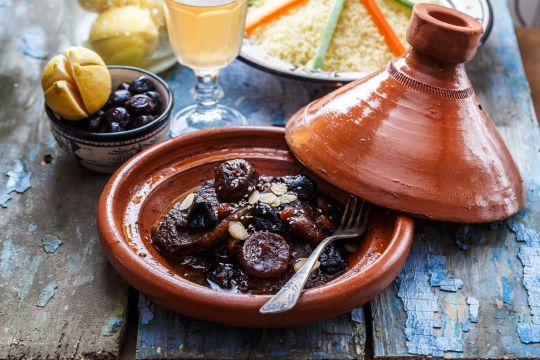|
Moroccan Cuisine |
 Morocco is a foodie's heaven, and the country's history is reflected in its culinary arts. Being at the crossroads of many civilizations, the Moroccan cuisine has been influenced by the native Berber cuisine, the Arabic Andalusian cuisine brought by the Moriscos when they left Spain during the Spanish inquisition, Turkish cuisine and the Middle Eastern cuisines brought by Arabic and Jewish populations. All these groups left their countries in the Middle Ages and settled in Morocco, bringing with them traditional recipes which are now common in Morocco, but forgotten in the Middle East. Traces of all of these cultures can be found in four of the best-loved Moroccan dishes: couscous, bisteeya (a delectable three-layer pie wrapped in thin pastry which is both savory and sweet, mechoui (tender roasted lamb) and djej emshmel (succulent roasted chicken cooked with olives and lemon). The foods of Morocco take great advantage of the natural bounty of a country where eating is a social ritual. A signature characteristic is cooking fruit with meat, such as quince with lamb, or apricots with chicken. The meal usually begins with a series of hot and cold salads which are followed by a tagine, or stew. The heartiest plate, often a lamb or chicken dish, is next, followed by a heaping plate of couscous topped with meats and vegetables. A soothing cup of sweet mint tea is the grace note to this repast. |
 Perhaps the most recognizable Moroccan dish is couscous, which is very old and probably of Berber origin. The Moroccan national dish is couscous with seven vegetables. Couscous is a small grain sized "pasta" made from wheat semolina flour, and every vegetable adds an important dimension to this famous dish. Tajine is the name of a wonderful conical Moroccan cooking pot as well as the name of the recipe itself. Tajine recipes are aromatic and full of flavor. They are stews of meat, fruit, vegetables, and spices, slow cooked over coals or open flame. The cone-shaped cover acts like an oven and the sealed lid retains heat and moisture, which prevents food from drying out during the cooking process and allows the slow infusion of flavors throughout the dish. The lid has an extended knob at the top, which is designed to remain cooler and act as a handle. |
|
|





